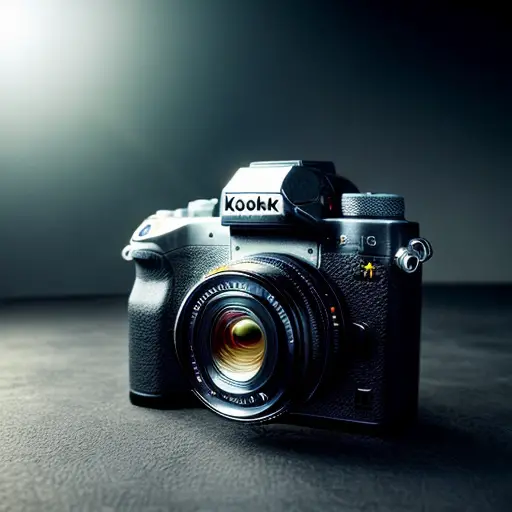The Dawn of a Digital Era: Kodak's Bold Move into the Digital Camera Market
Picture this: it was a time when film cameras ruled the world, and the idea of capturing a moment without the satisfying click of a shutter seemed inconceivable. But then, like a flash of lightning in a dark room, Kodak emerged from the shadows with a bold move into the digital camera market. With their innovative technology, they shattered the traditional photography paradigm, leaving photographers both excited and slightly bewildered. Suddenly, the world was introduced to a new era, where pixels replaced negatives, and memory cards became the new film rolls. Kodak's audacious leap into the digital realm was like a comedic plot twist in a movie, leaving us all wondering, 'What's next? Will our beloved film cameras become mere relics of the past?' Only time would tell, but one thing was for sure: Kodak had just pressed the shutter on a whole new chapter in photography history.
The Evolution of Photography: Kodak's Visionary Approach to Embrace Digital Technology
When Kodak introduced their first digital camera, the Kodak DCS 100, in 1991, it had a resolution of only 1.3 megapixels. Despite its low resolution by today's standards, this camera marked a significant milestone in the history of photography as it was the first commercially available digital camera. It revolutionized the industry by paving the way for the digital photography era we are familiar with today.
Imagine a world where photography was confined to darkrooms and the anticipation of waiting for film to develop. Then, like a burst of light, Kodak stepped onto the scene with a visionary approach to embrace digital technology. With the introduction of their digital camera, they revolutionized the way we capture and share moments. It was a game-changer, a seismic shift that transformed photography from a laborious process to an instant gratification. Kodak's bold move not only showcased their ability to adapt to the changing times but also paved the way for a new era of creativity and innovation. From that moment on, photography would never be the same, and Kodak's name would forever be etched in the annals of technological evolution.
Unveiling the Game Changer: Kodak's First Digital Camera and its Impact on the Industry

In a world dominated by film cameras, where the click of a shutter and the anticipation of developing prints were the norm, Kodak took a daring leap into uncharted territory. With the unveiling of their first digital camera, they forever changed the photography industry. It was a watershed moment, a game-changer that left photographers and enthusiasts alike in awe.
Gone were the days of film rolls and darkrooms. Kodak's digital camera introduced a new era of convenience and instant gratification. No longer did photographers have to wait to see their shots; they could now preview and delete images on the spot. It was a revolution that transformed the way we captured and shared moments, forever altering the landscape of photography.
Kodak's visionary approach to embrace digital technology not only showcased their adaptability but also set a precedent for the industry. Their digital camera became a catalyst for innovation, inspiring other companies to follow suit and develop their own digital imaging solutions. Suddenly, the market was flooded with a plethora of digital cameras, each vying for a piece of the pie that Kodak had so boldly carved.
The impact of Kodak's first digital camera extended far beyond the realm of photography. It paved the way for advancements in technology, influencing the development of smartphones with built-in cameras and the rise of social media platforms centered around sharing visual content. Kodak's bold move into the digital camera market was a seismic shift that forever altered the way we capture, preserve, and interact with images.
Looking back, it's hard to imagine a time when digital photography wasn't the norm. But thanks to Kodak's audacious leap into the digital realm, we now live in a world where capturing and sharing moments is as easy as a click of a button. Their first digital camera will forever be remembered as a game-changer, a milestone in the evolution of photography that shaped the industry and our lives in ways we could have never imagined.
Navigating Challenges and Embracing Opportunities: Kodak's Journey in the Digital Camera Market
A fun fact about when Kodak introduced their digital camera is that it was actually invented by an engineer named Steve Sasson, who worked for Kodak. He built the first digital camera prototype in 1975, which weighed about 8 pounds and had a resolution of 0.01 megapixels. It took 23 seconds to capture the first digital image, which was a black-and-white photo of a lab technician. However, Kodak initially dismissed the potential of digital photography, as they were primarily focused on their film business. It wasn't until the late 1990s that Kodak fully embraced digital photography and started producing digital cameras for consumers.
When Kodak introduced their digital camera, they embarked on a journey filled with both challenges and opportunities. As pioneers in the industry, they faced skepticism and resistance from traditionalists who clung to their beloved film cameras. However, Kodak remained steadfast in their belief in the power of digital technology. They navigated through the hurdles, adapting their strategies and refining their products to meet the evolving demands of the market. Along the way, they discovered new avenues for growth and innovation, seizing opportunities to expand their reach and influence. Kodak's journey in the digital camera market was a testament to their resilience and determination, proving that embracing change and embracing opportunities can lead to remarkable success.

